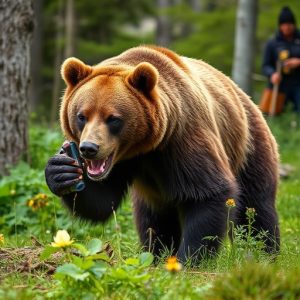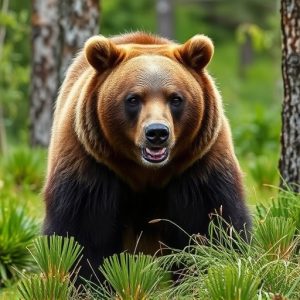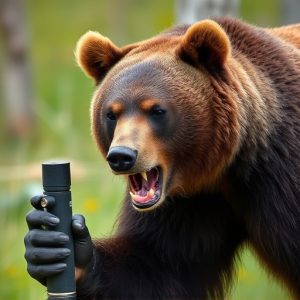Mastering Alaska’s Bear Spray Fog Pattern Test
The Bear Spray Fog Pattern Test is a crucial evaluation for ensuring safety in Alaska's wildern…….
The Bear Spray Fog Pattern Test is a crucial evaluation for ensuring safety in Alaska's wilderness, simulating real-life bear encounters to assess spray coverage and effectiveness. This test measures the radius and consistency of bear spray fog, helping users choose suitable products and prepare for potential threats. By mimicking scenarios with mannequins, accounting for wind, and analyzing results, individuals can optimize their protective gear and strategies for safe interactions with bears in diverse Alaskan landscapes.
Uncovering the secrets behind Alaska’s bear spray fog pattern test is crucial for anyone venturing into bear country. This article delves into the science behind this vital safety measure, exploring key components of successful testing and how to interpret the results. From understanding the bear spray fog pattern test to best practices for use in Alaska, you’ll gain insights that could save your life. Discover what makes a dynamic defense strategy effective against these powerful animals.
- Understanding Bear Spray Fog Pattern Test
- Key Components of a Successful Test
- Interpreting Results: What Does the Pattern Mean?
- Best Practices for Using Bear Spray in Alaska
Understanding Bear Spray Fog Pattern Test
Understanding the Bear Spray Fog Pattern Test is essential for anyone venturing into Alaska’s wilderness. This test assesses how effectively bear spray disperses and creates a protective fog when sprayed in simulated encounters with bears. It measures the radius and consistency of the spray’s coverage, crucial factors in ensuring personal safety during potential bear encounters.
The Bear Spray Fog Pattern Test mimics real-life scenarios by releasing a controlled stream of bear spray into a designated area. The pattern formed by the spray is then analyzed to determine its ability to create a dense fog that can deter and escape aggressive bears. This test provides valuable insights into the performance of different bear spray brands, helping users make informed decisions about their safety equipment.
Key Components of a Successful Test
When conducting a Bear Spray Fog Pattern Test, several key components come into play to ensure its effectiveness and success. Firstly, the distance at which the spray is tested is crucial; simulations should mimic real-world scenarios where bears are known to be present, typically within 20 to 50 feet (6 to 15 meters). This ensures the spray reaches the intended target range.
Secondly, the testing environment must replicate natural conditions as closely as possible. Factors like wind speed and direction significantly impact the spray’s dispersion; tests should account for these variables to accurately predict the bear spray fog pattern. Additionally, using realistic mannequins or dummies allows for a more precise evaluation of the spray’s reach and effectiveness in various orientations and positions, mirroring potential encounters with bears in the wild.
Interpreting Results: What Does the Pattern Mean?
When conducting a Bear Spray Fog Pattern Test, understanding the results is crucial for assessing the product’s effectiveness. The bear spray fog pattern provides valuable insights into how the spray will perform in real-world scenarios. A well-dispersed, even fog pattern indicates optimal performance, ensuring maximum coverage of the targeted area. This is particularly important when considering the spray’s range and the time it takes for the active ingredients to take effect.
The Bear Spray Fog Pattern Test allows users to visualize how the spray will interact with potential bear encounters. If the pattern reveals uneven distribution or significant droplet sizes, it could suggest issues with the spray’s aerosolization. This knowledge enables consumers to make informed decisions about which bear spray product best suits their needs, ensuring they are prepared for any wildlife interactions while outdoor recreation or in remote areas.
Best Practices for Using Bear Spray in Alaska
When it comes to bear spray, understanding the fog pattern test is just as crucial as knowing how to deploy it. The ideal bear spray should create a dense, even fog that blankets the target area, ensuring maximum coverage against potential bear encounters. During your Alaska adventure, remember that the spray’s effectiveness depends on factors like wind speed and direction, terrain, and distance from the bear. Therefore, always conduct a test before using it in real-life situations. Aim at a nearby tree or rock to observe the fog pattern; it should be uniform and not too light or too heavy, allowing you to assess its range and power accurately.
Best practices dictating how and when to use bear spray include remaining calm during an encounter, making yourself appear larger by raising arms or clothing, and shouting firmly while slowly backing away. Only resort to spraying when a brown bear exhibits aggressive behavior or charges at you. Aim for the face and eyes, as this is where bears have sensitive nerve endings, temporarily disorienting them. Keep in mind that weather conditions can affect spray range and visibility, so adjust your strategy accordingly during your outdoor activities in Alaska’s stunning landscapes.
The Bear Spray Fog Pattern Test is an essential tool for ensuring effective bear spray performance in Alaska’s diverse terrain. By understanding the key components and interpreting the fog pattern, users can make informed decisions about their safety while outdoors. Best practices highlight the importance of proper usage, storage, and knowledge of local regulations. Knowing how to effectively utilize bear spray can significantly enhance personal safety during encounters with bears in this unique ecosystem.


